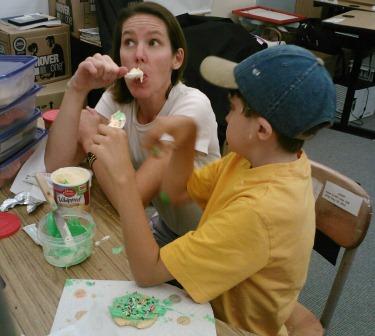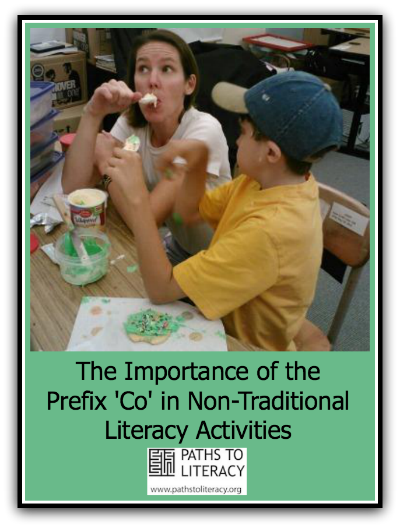The Importance of the Prefix "Co" in Non-Traditional Literacy Activities
Megan Mogan, MS, CCC-SLP, Speech-Language Pathologist

I’m sure you are a little confused that this is a literacy post and I am stuffing frosting into my face next to a student in the photograph to the left. Well, I promise you it’s a literacy activity, though not in the “traditional sense.” Let me explain…
Several years ago I received specialized training in deafblindness here in Arizona. At about the same time I was reading one of Dr. Jan van Dijk’s essential strategies for deafblind learners known as “Coactive Movement,” the phrase “Do WITH not FOR” was being repeated over and over. I may have been in a training on deafblindness, but these core concepts forever changed the way I worked with VI students with multiple disabilities. My most successful students had someone who did things WITH them when they were learning something for the first time. It seemed so obvious, yet I was not practicing this in my daily interactions. I never took the prefix “co-“ for granted again, and I saw my students as competent, willing, and thoughtful participants throughout our language and literacy activities.
Because my VI students with multiple disabilities accessed literacy non-traditionally anyway, we used co-active movement activities as a way to generate topics that we would later co-write and co-read about using permanent object, partial-object, braille, print, and drawn representations. Nowadays my co-workers (see what I did there?) are used to seeing me co-hip hop, co-crawl, co-frost, co-rock, co-giggle, and co-roll in my therapy sessions. These are the topics that are meaningful to some of my most involved students. Our interactions with these topics and with each other (the “co-“) serve as a non-traditional, though critical mode of reading and writing. This has resulted in several years of literacy materials generated through student-chosen topics. The best part of it all? I got to write and read WITH my students, not FOR them.
What are some of your student’s favorite co-active movement activities? Do you use these activities as topics and routines throughout the day? Have you written about them using non-traditional literacy modes?
See also Conversations without Language: Building Quality Interactions with Children Who Are Deafblind.


Comments
co-active activities